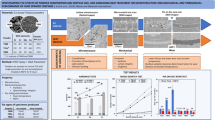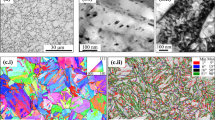Abstract
The role of a carbon-fluorine-containing additive in a flux based on the slag of silicomanganese in the formation of the structural-phase state, dislocation substructure, and fracture surface of the coating fabricated by electric arc surfacing using an Sv-08GA wire is analyzed. The relative ferrite and perlite contents and the scalar and excess dislocation densities are quantitatively estimated.





Similar content being viewed by others
REFERENCES
E. V. Kapralov, S. V. Raikov, E. A. Budovskikh, V. E. Gromov, E. S. Vashchuk, and Yu. F. Ivanov, “Structure, phase composition, and properties of surfacing formed on steel by electric arc method,” Fundam. Probl. Sovr. Materialoved. 11 (3), 334–339 (2014).
V. E. Gromov, E. V. Kapralov, S. V. Raikov, Yu. F. Ivanov, and E. A. Budovskikh, “Structure and properties of wear-resistant coatings deposited by the electric arc method on steel with flux-cored electrodes,” Usp. Fiz. Met. 15, 211–232 (2014).
R. Li, D. Y. He, Z. Zhou, Z. J. Wang, and X. Y. Song, “Wear and high temperature oxidation behavior of wire arc sprayed iron based coatings,” Surf. Eng. 30, 784–790 (2014).
R. Kejžar and J. Grum, “Hardfacing of wear-resistant deposits by MAG welding with a flux-cored wire having graphite in its filling,” Weld. Int. 20, 961–976 (2005).
H. R. Ma, X. Y. Chen, J. W. Li, C. T. Chang, G. Wang, H. Li, X. M. Wang, and R. W. Li, “Fe-based amorphous coating with high corrosion and wear resistance,” Surf. Eng. 46, 1–7 (2016).
Yu. Zhuk, “Super-hard wear-resistant coating systems,” Mater. Technol. 14, 126–129 (1999).
M. Kirchgabner, E. Badisch, and F. Franek, “Behaviour of iron-based hard facing alloys under abrasion and impact,” Wear 265, 772–779 (2008).
N. A. Kozyrev, A. I. Gusev, R. E. Kryukov, A. A. Usol’tsev, and L. P. Baschenko, “Development of new flux-cored electrodes for surfacing. Flux-cored electrode for surfacing of the parts working under shock-abrasive wear conditions,” Chern. Metall. Byul. Nach.-Tekh. Ekonom. Inf., No. 7, 70–77 (2018).
N. A. Kozyrev, R. E. Kryukov, N. E. Kryukov, A. A. Usol’tsev, and A. R. Mikhno, “Development of new welding fluxes using carbon-fluorinated additives,” Teoriya Tekhnol. Metall. Proizv., No. 3(26), 17–25 (2018).
Electron-Ion-Plasma Modification of the Surfaces of Nonferrous Metals and Alloys, Ed. by N. N. Koval and Yu. F. Ivanov (NTL, Tomsk, 2016).
F. R. Egerton, Physical Principles of Electron Microscopy (Springer Int. Publ., Basel, 2016).
C. S. S. R. Kumar, Transmission Electron Microscopy. Characterization of Nanomaterials (Springer, New York, 2014).
C. B. Carter and D. B. Williams, Transmission Electron Microscopy (Springer Int. Publ., Berlin, 2016).
V. P. Rotshtein, D. I. Proskurovskii, and G. E. Ozur, Modification of the Surface Layers of Metallic Materials by Low-Energy High-Current Electron Beams (Nauka, Novosibirsk, 2019).
Fractography and Atlas of Fractographs: A Handbook (Metallurgiya, Moscow, 1982).
L. M. Utevskii, Diffraction Electron Microscopy in Metal Science (Metallurgiya, Moscow, 1973).
K. Andrews, D. Dyson, and S. Keown, Interpretation of Electron Diffraction Patterns (Macmillan, London, 1968).
K. S. Chernyavskii, Stereology in Metal Science (Metallurgiya, Moscow, 1977).
N. A. Koneva, E. V. Kozlov, L. I. Trishkina, and D. V. Lychagin, “Long-range stress fields, curvature–torsion of a crystal lattice, and the stages of plastic deformation. Measurement methods and results,” in Proceedings of International Conference on New Methods in Physics and Mechanics of Deformable Solids (TGU, Tomsk, 1990), pp. 83–93.
P. Hirsch, A. Howie, R. Nicholson, D. Pashley, and M. Whelan, Electron Microscopy of Thin Crystals (Plenum, New York, 1967).
Author information
Authors and Affiliations
Corresponding author
Ethics declarations
The authors declare that they have no conflicts of interest.
Additional information
Translated by K. Shakhlevich
Rights and permissions
About this article
Cite this article
Kryukov, R.E., Gromov, V.E., Ivanov, Y.F. et al. Role of a Carbon-Fluorine-Containing Additive in the Formation of the Structure, Defect Substructure, and Fracture Surface of an Electric Arc Sprayed Coating. Russ. Metall. 2022, 1307–1311 (2022). https://doi.org/10.1134/S0036029522100159
Received:
Revised:
Accepted:
Published:
Issue Date:
DOI: https://doi.org/10.1134/S0036029522100159




